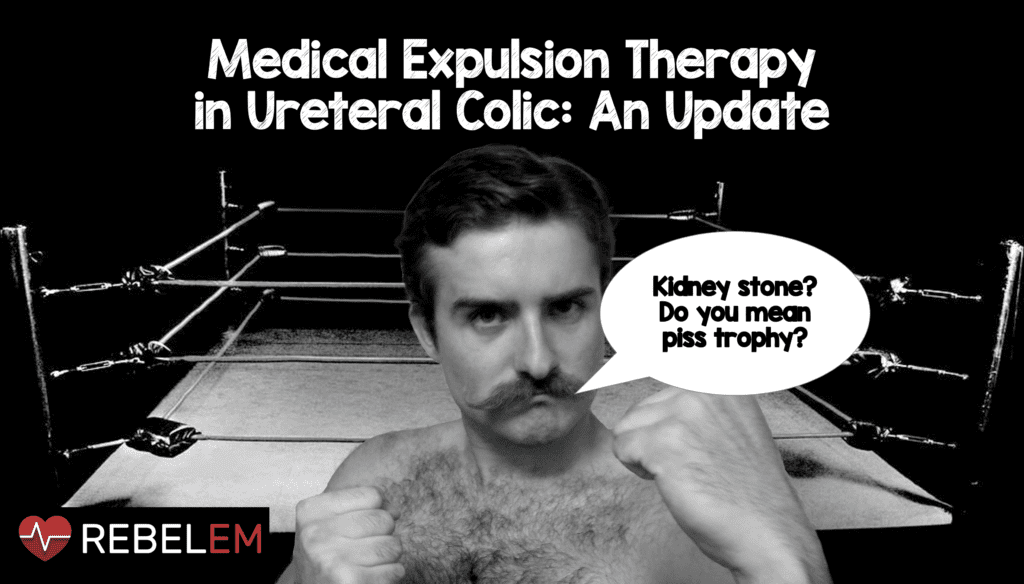
 Back in August 2014, we posted an in depth review on medical expulsion therapy (MET) with tamsulosin in patients with renal colic. The summary of that post was:
Back in August 2014, we posted an in depth review on medical expulsion therapy (MET) with tamsulosin in patients with renal colic. The summary of that post was:
“Clearly, there is disagreement in the literature. None of the studies are ideal. We continue to lack a large, RDCT done on patients presenting to the Emergency Department with renal colic.
The best evidence we have DOES NOT show a significant benefit to the use of tamsulosin in renal colic.”
Since that post, two well done RDCTs were published so we thought a brief review of each of these articles and updated recommendations were warranted.

Picard R et al. Medical expulsive therapy in adults with ureteric colic: a multicentre, randomised, placebo-controlled trial. Lancet 2015.
Details
- RDCT performed in 24 UK hospitals including 1167 patients (379 patients receiving nifedipine, 378 patients receiving tamsulosin and 379 patients receiving placebo)
- Primary outcome – Need for urologic intervention to facilitate stone passage at 4 weeks after randomization.
Critical Findings
- Primary endpoint: Placebo (20%) vs. Tamsulosin (19%) vs. Nifedipine (20%)
- No statistically significant difference between the three groups
- Lost to follow up: 14 patients (1.2%)
- MET was found to be beneficial in passage rate of lower ureteral tract stones (86% vs. 82%) but this was a not a prior specified subgroup analysis
Strengths: This was a large, multicenter study with excellent methods and follow up (only 1.2% of patients lost). Additionally, 25% of the patients had “larger” stones (> 5 mm)
Author’s Conclusion: “Tamsulosin 400 μg and nifedipine 30 mg are not effective at decreasing the need for further treatment to achieve stone clearance in 4 weeks for patients with expectantly managed ureteric colic.”
Bottom Line: The Picard study represents the highest quality evidence on the utility (or in this case, the lack there of) for tamsulosin in the treatment of ureteral colic. Based on this data and that of the other randomized trials reviewed here, tamsulosin should not be standard care for patients presenting with ureteral colic.

Furyk JS et al. Distal ureteric stones and tamsulosin: a double-blind, placebo-controlled, randomized, multicenter trial. Ann Emerg Med 2015.
Details
- RDCT performed in 5 EDs in Queensland, Australia including 403 patients (202 patients receiving tamsulosin 0.4 mg once daily and 201 receiving placebo) with distal ureteric stones < 10 mm.
- Primary outcome – Stone expulsion at 28 days (confirmed by CT) and time to stone passage
- Subgroup outcome – Stone expulsion at 28 days in patients with stones 5-10 mm in size.
Critical Findings
- Primary endpoint: Tamsulosin 87% (140/161) vs. placebo 81.9% (127/155) stone passage at 28 days
- Non-statistically significant difference in passage rate at 28 days
- Follow up: 41 patients in the tamsulosin group and 46 patients in the placebo group did not have follow CTs performed at 28 days
- 5-10 mm stone subgroup: Tamsulosin 83.3% (30/36) vs placebo 61% (25/41) had stone passage at 28 days (statistically significant). NNT = 4.5
Strengths:
- This was a large, multicenter study with excellent methods and good (although not perfect) follow up (87/403 patients did not have repeat CT at 28 days).
- The study was specifically powered to detect a difference of 20% in stone passage rate (increase stone passage from 5% to 25%) for large stones (5-10 mm).
Author’s Conclusion: “We found no benefit overall of 0.4 mg of tamsulosin daily for patients with distal ureteric calculi less than or equal to 10 mm in terms of spontaneous passage, time to stone passage, pain, or analgesia requirements. In the subgroup with large stones (5 to 10 mm), tamsulosin did increase passage and should be considered.”
Bottom Line: The Picard and Furyk study represent the highest quality evidence on the utility (or in this case, the lack there of) for tamsulosin in the treatment of ureteral colic. Based on this data and that of the other randomized trials reviewed here, tamsulosin should not be standard care for patients presenting with ureteral colic. However, both of these studies show a benefit in the specific subgroup of patients with large, distal stones.

Clinical Bottom Line
These studies may have finally identified a population who will benefit. However, in order to identify this group, a CT scan will be required. In the past couple of years, we have recognized the issues of CT overuse, particularly in patients with ureteric colic. A return to scanning all of these patients would have an overall deleterious effect without a significant benefit. Scanning everyone looking for the small subgroup of patients that may benefit is nonsensical.
Read More
- Ryan Radecki at EM Lit of Note: And the Stoning Continues
- Rory Spiegel at EM Nerd: The Adventure of the Impassable Stone
- Anton Helman at Emergency Medicine Cases: BEEM Cases 2 – Renal Colic Imaging, Analgesia, Fluids & Medical Expulsive Therapy
References
- Picard R et al. Medical expulsive therapy in adults with ureteric colic: a multicentre, randomised, placebo-controlled trial. Lancet 2015. PMID: 25998582
- Furyk JS et al. Distal ureteric stones and tamsulosin: a double-blind, placebo-controlled, randomized, multicenter trial. Ann Emerg Med 2015. PMID: 26194935
Post Peer Reviewed By: Salim Rezaie (Twitter: @srrezaie)
The post Medical Expulsion Therapy in Ureteral Colic: An Update appeared first on REBEL EM - Emergency Medicine Blog.
